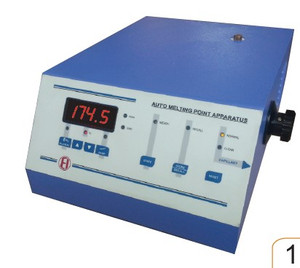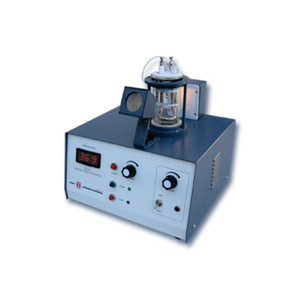
Digital Melting Point Apparatus
EI-OCTOVISION
₹36,900.00 - ₹40,900.00 Excl. GST
Digital Melting Point Apparatus
Digital Melting Point Apparatus: Precision Temperature Analysis for Laboratory Applications
The Digital Melting Point Apparatus is a sophisticated laboratory instrument specifically designed for accurate measurement of melting points and melting ranges of solid samples. This ISO 9001:2000 certified equipment delivers exceptional precision for pharmaceutical, chemical, and educational laboratories requiring reliable crystalline sample analysis.Key Features & Benefits Digital Melting Point Apparatus
- High-Precision Temperature Display - 4-digit seven segment red LED display with model-specific resolution (0.1°C in model 935, 1°C in model 934)
- Wide Temperature Range - Testing capability from ambient to 300°C for diverse sample analysis
- Silicon Oil Bath System - 200ml capacity bath with Teflon cover ensures uniform heat distribution
- Integrated Magnetic Stirrer - Built-in stirring capability with adjustable speed for consistent temperature throughout the oil bath
- Specialized Teflon Cover - Features 5 strategic openings for capillaries (3), boiling point tube (1), and thermometer (1)
- Enhanced Visibility - Large magnifier and glare-free background illuminator for strain-free sample observation
- Precision Heating Control - Electronic controller with indicator for precise adjustment of heating rate
- Platinum Resistance Sensor - PT-100 RTD sensor for accurate temperature measurement
- Simple Operation - Intuitive Start/Stop/Clear controls for straightforward testing procedure
- Temperature Range Selector - High/Low range selector switch for optimized measurement control
- Memory Function - Display retains last measured temperature reading for reference
- Special Immersion Heater - Designed specifically for optimal oil bath heating characteristics
- Compact Design - Space-efficient laboratory footprint (315 × 290 × 230mm)
- ISO 9001:2000 Certification - Guaranteed quality construction and performance
- 1-Year Warranty - Comprehensive coverage for reliability and peace of mind
Technical Specifications Digital Melting Point Apparatus
| Parameter | Specification |
|---|---|
| Model Options | 935 (0.1°C resolution) 934 (1°C resolution) |
| Temperature Range | 0-300°C on a 4-digit LED display |
| Temperature Resolution | Model 935: 0.1°C Model 934: 1°C |
| Temperature Sensor | PT-100 RTD sensor |
| Oil Bath | Silicon oil bath - 200 ml capacity Teflon cover with three capillary holes, one boiling point tube hole, and one thermometer hole Includes special oil immersion heater |
| Stirrer Speed | Controllable with front knob |
| Capillary Glass Tube | 12mm long, 0.8 to 1.1mm internal diameter |
| Sample Requirements | Fine powder properly dried at a temperature considerably below its melting point, 4 to 6 mm high |
| Dimensions | 315 × 290 × 230mm (L×B×H) (Approx.) |
| Power Requirements | 230V ±10% AC, 50 Hz |
| Weight | 12 Kg. (Approx.) |
| Controls | Start, Stop, Clear switches High/Low range temperature selector Heating rate controller |
| Display | 4-digit seven segment red LED |
| Warranty | 1 Year |
| Certification | ISO 9001:2000 |
Included Accessories Digital Melting Point Apparatus
- Box of Capillaries
- Glass Tubes for Liquid Sample (6 × 75 mm) - 2 Nos.
- Magnetic Capsule
- Bottle of Silicon Oil - 250 ml
- Glass Cylindrical Beaker with Teflon cover fitted with immersion heater
- Instruction Manual
- Dust Cover
How It Works
Precision Testing Process Digital Melting Point Apparatus
The Digital Melting Point Apparatus employs a methodical approach to melting point determination:- Sample Preparation - The solid sample is finely powdered and dried at a temperature well below its melting point
- Capillary Loading - A 4-6mm column of sample is loaded into glass capillary tubes
- Bath Setup - The silicon oil bath is filled and the magnetic stirrer activated to ensure uniform temperature distribution
- Capillary Placement - Sample-filled capillaries are inserted into the designated holes in the Teflon cover
- Temperature Control - The heating rate is adjusted using the electronic controller
- Measurement Initiation - The 'Start' switch is pressed to begin temperature monitoring
- Sample Observation - The sample is viewed through the magnifier and illuminator to observe phase changes
- Result Recording - When melting occurs, the 'Stop' switch is pressed to capture the temperature reading
- Temperature Display - The 4-digit LED display shows the temperature at which the sample melted
Silicon Oil Bath Technology Digital Melting Point Apparatus
The heart of the Digital Melting Point Apparatus is its sophisticated oil bath system:- Uniform Heat Distribution - The 200ml silicon oil bath provides consistent temperature throughout the testing environment
- Integrated Magnetic Stirring - Continuous stirring eliminates temperature gradients within the oil bath
- Specialized Immersion Heater - Custom-designed heater ensures optimal heat transfer to the oil
- Precise Temperature Control - Electronic controller allows fine adjustment of heating rate
- PT-100 RTD Sensor - Professional-grade platinum resistance temperature detector provides accurate readings
- Teflon Cover Design - Strategic placement of openings allows proper alignment of capillaries for observation
Applications
Pharmaceutical Quality Control Digital Melting Point Apparatus
- Raw Material Verification - Confirm identity and purity of pharmaceutical ingredients
- Batch Quality Testing - Ensure consistent quality of manufactured compounds
- USP/EP/JP Compliance - Meet pharmacopeia requirements for melting point determination
- Stability Testing - Monitor physical property changes during stability studies
- Polymorphism Detection - Identify different crystalline forms of the same compound
Chemical Analysis & Research
- Compound Identification - Characterize synthesized or isolated compounds
- Purity Assessment - Evaluate sample purity through melting range analysis
- Eutectic Mixture Analysis - Determine composition through melting behavior
- Crystallization Studies - Analyze crystallization patterns and properties
- Quality Verification - Confirm specifications of purchased chemicals
Educational Applications Digital Melting Point Apparatus
- Laboratory Instruction - Teach fundamental analytical techniques to students
- Physical Chemistry Demonstrations - Illustrate principles of phase transitions
- Organic Chemistry Labs - Support compound identification and purity assessment
- Student Research Projects - Provide reliable equipment for undergraduate and graduate research
- Technique Development - Build skills in physical property determination
Industrial Quality Control
- Wax and Polymer Testing - Determine melting characteristics of industrial materials
- Food Science Applications - Analyze fats, lipids, and crystalline food components
- Material Verification - Confirm consistency of incoming materials
- Product Development - Characterize properties of new formulations
Key Advantages for Laboratory Use
Superior Accuracy & Precision Digital Melting Point Apparatus
The Digital Melting Point Apparatus delivers exceptional measurement quality through several key design features:- High-Resolution Digital Display - Model 935 provides 0.1°C resolution for detailed analysis
- PT-100 RTD Sensor - Laboratory-grade platinum resistance sensor ensures accurate readings
- Uniform Oil Bath Heating - Magnetic stirring eliminates temperature gradients
- Controlled Heating Rate - Adjustable heating allows optimization for different sample types
- Enhanced Visibility - Magnifier and glare-free illumination for precise observation of phase changes
User-Friendly Operation Digital Melting Point Apparatus
Designed for straightforward use in busy laboratory environments:- Intuitive Controls - Simple Start/Stop/Clear operation
- Clear Digital Readout - Bright LED display shows temperature readings
- Memory Feature - Last temperature reading is retained until cleared
- Adjustable Stirring Speed - Front knob control for easy adjustment
- High/Low Range Selector - Optimizes measurement for different temperature ranges
- Visual Indicators - Pilot lamp shows operational status
Practical Laboratory Design Digital Melting Point Apparatus
Engineered for the realities of daily laboratory use:- Compact Footprint - Efficient use of valuable bench space
- Complete Accessory Package - All necessary components included
- Multiple Sample Testing - Three capillary positions allow simultaneous testing
- Boiling Point Capability - Dedicated position for boiling point tube
- Durable Construction - Built for continuous laboratory operation
- Protective Dust Cover - Safeguards instrument when not in use
Operating Instructions Digital Melting Point Apparatus
- Instrument Setup
- Place the apparatus on a flat, stable surface
- Fill the bath with silicon oil to the appropriate level (approximately 200ml)
- Connect to power supply (230V ±10% AC, 50Hz)
- Turn on the instrument using the ON/OFF switch (pilot lamp will illuminate)
- Sample Preparation
- Grind the solid sample into a fine powder
- Ensure sample is completely dry (pre-dry if necessary at temperature well below melting point)
- Pack capillary tube by gently tapping open end into the powdered sample
- Ensure sample column height is 4-6mm at bottom of capillary
- Tap capillary on hard surface to compact the sample at the closed end
- Testing Procedure
- Insert loaded capillaries into designated holes in the Teflon cover
- Set the High/Low range temperature selector switch as appropriate
- Adjust the heating rate using the electronic controller
- Activate the magnetic stirrer and adjust speed with the front knob
- Press the 'Start' switch to begin temperature monitoring
- Observe the sample through the magnifier with illumination
- When melting begins, note the temperature on the digital display
- When melting is complete, press the 'Stop' switch
- Record the final temperature shown on the display
- System Reset Digital Melting Point Apparatus
- Press 'Clear' switch to reset the display for the next test
- Allow the oil bath to cool before removing samples or changing capillaries
- Turn off the instrument when testing is complete
Maintenance & Care Digital Melting Point Apparatus
- Oil Bath Maintenance - Replace silicon oil periodically or when discolored
- Cleaning - Keep the illuminator and magnifier clean for clear observation
- Capillary Management - Dispose of used capillaries properly; never reuse
- Temperature Verification - Periodically check accuracy with certified reference materials
- Stirrer Care - Ensure magnetic capsule is clean and rotates freely
- Surface Cleaning - Wipe external surfaces with slightly damp cloth; avoid solvents
- Storage - Use the provided dust cover when instrument is not in use
About Electronics India Digital Melting Point Apparatus
Electronics India is an ISO 9001:2000 certified manufacturer of precision laboratory and analytical equipment. With a comprehensive product range that includes spectrophotometers, analytical instruments, testing apparatus, and laboratory equipment, the company has established a reputation for delivering reliable, high-quality instruments for pharmaceutical, research, educational, and industrial applications. Their commitment to quality is demonstrated through ISO certification and comprehensive warranty coverage. Electronics India continues to develop innovative solutions for analytical testing needs across various sectors, combining precision technology with practical laboratory functionality.Additional Products in the Electronics India Range
Electronics India offers a complete line of analytical and testing equipment including:- UV/VIS Spectrophotometers (Single and Double Beam)
- Semi-Auto Analyzers
- Flame Photometers and Hemoglobin Meters
- Photo Colorimeters and Fluorometers
- pH, Conductivity, TDS, DO, and Salinity Meters
- Dissolution and Disintegration Test Apparatus
- Friability Test Apparatus
- Turbidity Meters and Nephelometers
- Colony Counters
- Karl Fischer Moisture Titrators
- Telethermometers and Temperature Indicators
- Water & Soil Analysis Kits
- Portable Testing Equipment
- Various Microscopes (Student, Binocular, Medical, Co-Axial)





